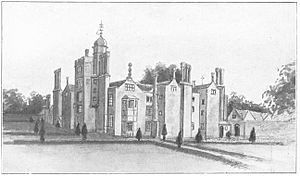Oswald Tesimond facts for kids
Oswald Tesimond (born in 1563 – died 23 August 1636) was an English Jesuit. Jesuits are members of a Catholic religious order. Tesimond was born in either Northumberland or York. He is known for having some knowledge of the Gunpowder Plot before it happened, even though he was not directly involved in planning it.
Contents
Early Life and Education
Oswald Tesimond went to school in York. He attended the Royal School of William and Mary, which was free to attend. Interestingly, some of his classmates later became involved in the famous Gunpowder Plot. These included Guy Fawkes, Edward Oldcorne, and the brothers Christopher and John Wright.
In 1580, when he was seventeen years old, Tesimond went to the English College in Rome. After studying philosophy for three years, he decided to join the Society of Jesus in April 1584. The Society of Jesus is another name for the Jesuits.
Life as a Jesuit
Tesimond spent much of his adult life in Italy. He used the name Philip Beaumont during this time. He studied theology in Messina, a city in Italy, and later taught philosophy there. He became a priest before he left Italy for England in November 1587.
He arrived in Gravesend, England, on 9 March 1598. For eight years, Tesimond worked as a missionary, helping Catholics in England. He worked with Edward Oldcorne in the areas of Worcestershire and Warwickshire. He was known as "Father Greenway" and often worked from a place called Hindlip Hall. On 28 October 1603, he officially became a full member of the Jesuit order.
The Gunpowder Plot Connection
Oswald Tesimond had a small connection to the Gunpowder Plot. This was a plan by a group of English Catholics to blow up the Houses of Parliament in 1605. Tesimond was not part of the planning. However, he learned about the plot from Robert Catesby, one of the main conspirators.
Catesby asked Tesimond for advice about whether it was right to accidentally cause the death of innocent people. At first, Tesimond thought Catesby was talking about fighting in wars. But he soon became worried. Tesimond then told his Jesuit superior, Henry Garnet, about his concerns during confession. Garnet felt he could not share this information because he heard it in confession, which is a secret. However, Garnet told Tesimond to try and convince Catesby to stop his plans.
Garnet later told Catesby that the Pope did not want English Catholics to cause trouble. He warned that it would only lead to harsher treatment for them. But Catesby did not change his mind. Tesimond and Garnet kept their knowledge secret, which was against the law at the time.
After the plot was discovered, the government's lawyer, Sir Edward Coke, said that the Jesuits were involved. However, Thomas Wintour, one of the plotters, said that Tesimond and other Jesuits had not helped or advised the plot.
Escape and Later Years
After the Gunpowder Plot was discovered, an arrest warrant was issued for Tesimond on 15 January 1606. The warrant described him in detail, mentioning his black hair, brown beard, and lean face.
Tesimond managed to avoid being arrested. He escaped from London and found safe places to hide in Essex and Suffolk. He then sailed to Calais, France, by hiding among a cargo of dead pigs. He pretended to be the owner of the cargo. From Calais, he traveled to Boulogne and then to Saint-Omer.
Tesimond spent several years in Saint-Omer. While there, he wrote a detailed story about the Gunpowder Plot. This story was written in Italian and is one of the most complete accounts of the plot. He sent his story to Rome to inform the Jesuit leaders.
Later, starting in 1617, Tesimond worked in Messina again. He was in charge of studies there for many years. He also spent some time in Rome in 1621. Eventually, he moved to Naples, Italy, where he passed away in 1636 at the age of 73. Even after his death, people in England were still worried about the Gunpowder Plot. For example, Sir Edwin Rich wrote a letter to James I of England, warning the king about possible dangers from Tesimond.
Images for kids



